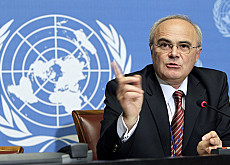Barceló unveils UN “Sistine Chapel” in Geneva

The Spanish abstract artist Miquel Barceló has unveiled his spectacular new artwork at the United Nations headquarters in Geneva.
But a row over Spanish taxpayer – and overseas development – money used to create the €20 million (SFr30.3 million) decorative ceiling for the UN Human Rights Council has cast a shadow over the celebrations.
The new Room of Human Rights and the Alliance of Civilisations – described as the Sistine Chapel of the 21st century – was inaugurated on Tuesday by Spain’s King Juan Carlos and Queen Sofia, Prime Minister José Luis Rodriguez Zapatero, UN Secretary-General Ban Ki-moon and Swiss President Pascal Couchepin.
In his inauguration speech, the UN secretary-general called on diplomats to bring to future human rights debates “the same sense of creativity” as the Spanish artist.
“Let’s not accept the status quo, but instead be visionary, creative and audacious,” he told the 700 invitees on Tuesday.
The massive conceptual artwork, a redesign of the 929 square metre dome which resembles a grotto with multicoloured stalactites, took over two years to complete, used 35,000 kg of paint and the services of 20 assistants, among them a cook and a cave expert.
The artistic project was launched in 2006 by Zapatero and his Turkish counterpart Recep Tayyip Erdogan to improve dialogue between the West and the Muslim world.
“The cave is a metaphor for the agora, the first meeting place of humans, the big African tree under which to sit to talk, and the only possible future: dialogue, human rights,” Barceló explained.
“The sea is the past, the origin of the species, and the promise of a new future: emigration, travel,” he added.
Technical challenge
To make the stalactites, some of which are up to three feet long, Barceló built a honeycomb of aluminium from which to hang resin forms. They are coloured with paint containing pigments from all over the world.
The Spanish artist promises that the stalactites are safe and won’t fall down.
“But some UN people told me that they would really like some of them to come down on certain diplomats’ heads at the UN Human Rights Council,” he joked to the French news agency, AFP.
The ceiling has been a “huge technical challenge”, working with art conservationists to guarantee the solidity and longevity of the pigments, according to Barceló, who worked for a year on the project in his workshop and 13 months in Geneva.
He had to invent a special high-powered paint spray to project the paint onto the ceiling.
“I had major difficulties at the beginning. I really didn’t grasp the size of this colossal space. It’s a technique I’ve already used on canvas but here I had to reinvent it and totally change the scale,” he explained.
In the end it’s a work that “changes according to where you are looking from. In itself, it’s a symbol of multilateralism”, he added.
Storm in a paint pot?
While few question the artistic value of the work created by the Mallorcan artist, its price tag for the Spanish taxpayer has sparked a huge political row back home.
The renovation of the room cost nearly €20 million (SFr30.2 million), 60 per cent of which has been paid by Spanish sponsors.
The remainder comes from the Spanish government, including €500,000 from a development aid fund.
The conservative Popular Party condemned the use of the development money as “irregular”, “abnormal” and possibly “illegal”.
“How many vaccines, how many wells, how many thousands of children in different countries could have been helped with this money?” asked Gonzalo Robles, a member of parliament from the opposition Popular Party.
The ruling Socialist Party has tried to shrug off the controversy, maintaining its innocence and insisting there was no problem with using the UN funds for the artwork.
Foreign Minister Miguel Angel Moratinos declined to specify the final cost. “Only fools confuse value and price. This project is a new way of carrying out diplomacy and foreign policy,” he said.
The development funds came out of what was not only intended for poor countries, the government claimed, but also for promoting “international solidarity” generally.
More cautious artist
Javier Garrigues, Spain’s ambassador to the UN, said the location justified the spending of aid money. “Funding the human rights headquarters clearly falls into the category of development aid,” he said.
The deputy prime minister, Maria Teresa Fernandez de la Vega, fearful of political backlash, has demanded full financial disclosure over the project.
Barceló, meanwhile, appeared unsurprised by the row, but admitted it had made him more cautious.
“It’s a political thing, and it has been used as a political weapon. It’s part of the game,” he said in an interview published in El País newspaper last Friday.
He added that the episode had taught him “to be careful in dealings with the political class and to spend more time in my workshop”.
swissinfo, Simon Bradley in Geneva
Barceló was born in 1957 in Felanitx on the island of Mallorca, and studied art at Palma de Mallorca and at Barcelóna.
He has mastered nearly all artistic techniques – ranging from painting and sculpture to performance art – soared to fame early in his career and is now regarded as one of the world’s top contemporary artists.
Discovered by the gallery owner Leo Castelli, Barceló initially became interested in the art brut movement and North American abstract expressionism.
He started to become better known internationally after taking part in the VII Documenta de Kassel contemporary art exhibition, where he met Joseph Beuys, Lucio Amelio, Francesco Clemente, Dokoupil, Walter Dahn, Keith Haring and Jean-Michel Basquiat. Thereafter followed a series of exhibitions at the Centre Pompidou and the Louvre in Paris, the Museo de Arte Contemporáneo in Barcelóna and the Centro Reina Sofía in Madrid.
Fascinated by processes of transformation on land and in the sea, Barceló sees his art as an “organized chaos” and as an “act of resistance”.
Among his other projects is a collection of modern terracotta murals created for a Gothic chapel in the cathedral of Palma de Mallorca, which was finished in 2007.
Dividing his time between his native Mallorca, Paris and Mali in West Africa, Barceló has absorbed a wide range of influences such as European baroque and other African styles.
The ceiling for the UN Human Rights Council conference room at the UN headquarters in Geneva is his largest work to date.

In compliance with the JTI standards
More: SWI swissinfo.ch certified by the Journalism Trust Initiative











You can find an overview of ongoing debates with our journalists here . Please join us!
If you want to start a conversation about a topic raised in this article or want to report factual errors, email us at english@swissinfo.ch.